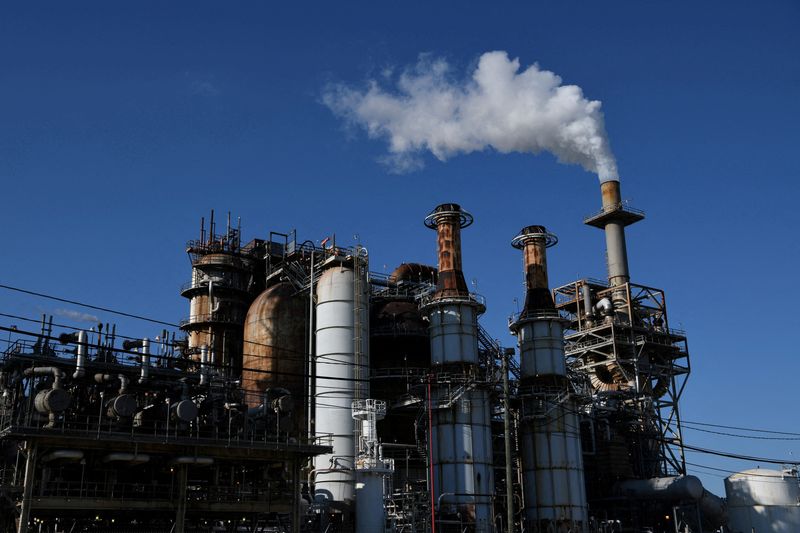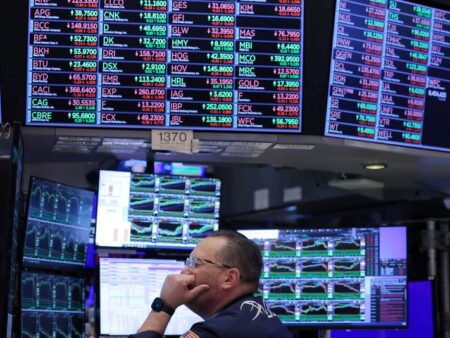By Nicole Jao
NEW YORK (Reuters) – Investors are souring on the U.S. oil refining sector, citing forecasts for softer fuel demand and worries that President-elect Donald Trump may slap tariffs on imports of crude.
U.S. refiner profits started to fall toward the end of 2023 as new refining capacity came online and margins returned to normal levels. This followed two years of bumper profits as refiners cashed in on supply shortages caused by Russia’s invasion of Ukraine and a post-pandemic recovery in demand.
Shares of major refiners have fallen this year, and on average, analysts have lowered expectations for refiners’ fourth-quarter earnings before interest, taxes and amortization (EBITA) by 24% since the start of the quarter, Tudor, Pickering, Holt & Co analyst Matthew Blair said in a note.
Blair noted the easing of gasoline crack spreads and persistently low diesel cracks. A crack spread is the difference between the price of a fuel and the price of . Blair also cited higher refinery utilization.
The U.S. gasoline futures crack spread over the cost of West Texas Intermediate (WTI) crude fell below $11 to a one-year low in December. The ultra-low sulphur diesel futures crack spread eased to a near two-month low of under $22 during the month.
U.S. refining utilization averaged 90.3% in the fourth quarter, up from 87.6% in the same quarter last year, according to Tudor, Pickering, Holt & Co.
“Following a year of negative revisions, analysts are likely to continue bringing estimates lower in 2025 on the back of a weaker forward curve,” Jefferies analysts said in a note.
Shares of Valero slipped more than 6% in 2024, while rival Phillips 66 (NYSE:) fell more than 15% during that period.
Shares of Marathon Petroleum (NYSE:) closed 2024 down 8% for the year.
Analysts polled by Reuters in January lowered their stock target price for all three refiners.
WEAKER DEMAND
Signs of slowing economic activity in the U.S. and China, the top oil consumer and top importer, respectively, weighed heavily on oil and fuel markets last year.
The U.S. is the world’s largest exporter of motor gasoline, supplying over 16% of total global exports, according to the U.S. Energy Information Administration.
The International Energy Agency increased its 2025 global oil demand growth forecast to 1.1 million barrels per day (bpd) in December, up from 990,000 bpd last month. But it said the gains would continue to be led by countries in emerging economies in Asia, which are not strong markets for U.S. refiners.
Moreover, global gasoline demand is expected to peak this year at around 28 million bpd amid surging electric vehicle adoption and improving vehicle efficiency, particularly in China, the world’s largest oil importer, according to S&P Global Commodity Insights.
MORE VOLATILITY AHEAD
Investors are also uncertain about U.S. government policies as they await the inauguration of Trump, analysts also said.
Last month, Trump pledged to impose a 25% tariff on all imports from Canada and Mexico until they clamp down on drug trafficking and migration. Tariffs on oil importers would have a big impact on refiners that process Canadian, Mexican and other imported crude, forcing them to pay more for their feedstock.
“Margins are going to be weak until we get a clear picture regarding the direction of economic growth and tariffs on Canada,” said Tortoise Capital portfolio manager Rob Thummel. “It’ll be a challenging environment until then.”
Tariffs would lead to higher prices and amplify slowing global oil demand, said Austin Lin, refining and oil products analyst at Wood Mackenzie.

There may be some support for fuel demand from other Trump policies.
Trump’s plans to roll back support for electric vehicles and charging stations could slow their sales and bolster gasoline demand, along with his pledges to block imports from China of cars, components and battery materials.
Source link
















